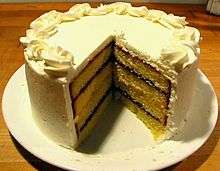Sponge cake
Sponge cake is a light cake made with eggs, flour and sugar,[1] sometimes leavened with baking powder.[2] Sponge cakes, leavened with beaten eggs, originated during the Renaissance, possibly in Spain.[3] The sponge cake is thought to be one of the first of the non-yeasted cakes, and the earliest attested sponge cake recipe in English is found in a book by the English poet Gervase Markham, The English Huswife, Containing the Inward and Outward Virtues Which Ought to Be in a Complete Woman (1615).[4] Still, the cake was much more like a cookie: thin and crispy. Sponge cakes became the cake recognized today when bakers started using beaten eggs as a rising agent in the mid-18th century. The Victorian creation of baking powder by English food manufacturer Alfred Bird in 1843 allowed the addition of butter to the traditional sponge recipe, resulting in the creation of the Victoria Sponge.
.jpg) Sponge cake (Victoria sponge) at a 2014 village fête baking competition | |
| Type | Cake |
|---|---|
| Course | Dessert, tea |
| Main ingredients | Wheat flour, sugar, egg whites, baking powder |
| Variations | Rice flour |
Background
The earliest known recipe for sponge cake (or biscuit bread) from Gervase Markham's The English Huswife (1615) is prepared by mixing flour and sugar into eggs, then seasoning with anise and coriander seeds.[5] 19th century descriptions of avral vary from place to place but it sometimes described as "sponge biscuits" or a "crisp sponge" with a light dusting of sugar ".[6] Traditional American sponge recipes diverged from earlier methods of preparation, adding ingredients like vinegar, baking powder, hot water or milk.[7]
Sponge cake covered in boiled icing was very popular in American cuisine during the 1920s and 1930s. The delicate texture of sponge and angel food cakes, and the difficulty of their preparation, meant these cakes were more expensive than daily staple pies. At the historic Frances Virginia Tea Room in Atlanta sponge cake with lemon filling and boiled icing was served, while New York City's Crumperie served not only crumpets but toasted sponge cake as well.[8][7]
Methods of preparation
The basic whisked sponge cake does not contain any fat. It is made by whisking eggs and caster sugar and gently folding in flour.[9] This type of cake is also called foam cake, depending on aeration of eggs and heat to rise.[10] Anne Willan has said that "sponge may have some butter added, but not much or it will not rise". Some types of sponge are baked in ungreased pans to improve the cake's rise by allowing the batter to adhere and climb the sides of the pan.[7] Cream of tartar or baking soda are recommended by some turn of the century cookbooks to make Swiss rolls more pliable and easier to roll.[11]
To make Genoise cake flour and melted butter are added to the egg mixture for a moister cake.[9] The "biscuit" sponge from early American cuisine is made by beating egg yolks with sugar, then alternately folding in whisked egg whites and flour. Willan says both types of sponge cake are represented in French cuisine.[7]
For some cakes like the Victoria Sponge, fat and sugar are creamed before eggs and flour are incorporated into the batter, similar to pound cake.[9][12] In British English layer cakes like the Victoria Sponge are called "sandwich sponge".[6] This type of buttery cake was not possible without baking powder, which was discovered by English food manufacturer Alfred Bird in 1843, allowing the sponge to rise higher.[13][14]
Sponge soaks up flavors from fresh fruits, fillings and custard sauces.[7] To maintain the moisture of the cake it is sometimes made with potato flour.[15] Although sponge cake is usually made without butter, its flavor is often enhanced with buttercream, pastry cream or other types of fillings and frostings.[10] The basic recipe is also used for madeleines, ladyfingers, and trifles, as well as some versions of strawberry shortcake.[9]
Types
Asian
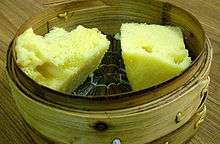
Steamed sponge cake like the ma lai gao are commonly found in Malaysia. Chinese almond sponge is steamed and topped with boiled icing, chocolate, vegetables or fresh fruit. Korean sponge called saeng is usually made with rice flour and topped with whipped topping and fruit. Some Vietnamese varieties may have fresh herbs like mint, lemon grass or basil added to the batter, and be topped with caramelized tropical fruit. Milk and jaggery are added to sponge cake in India which is served with the creamy Sri Lankan specialty "avocado crazy".[3] Western style sponge cakes topped with whipped cream and strawberries are popular in Japan where sponge is also used as a base for cheesecakes.[5]
Angel food cake

Angel food cake is a 19th-century American cake that contains no egg yolks or butter. The cake is leavened using only egg whites and baking powder.[5] This recipe can be traced to 18th century American cookbooks. The delicate cake is baked in an ungreased pan and cooled upside down.[7]
Chiffon cake
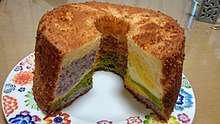
Chiffon cake is a light and moist cake made with vegetable oil. It is similar to angel food cake and was commonly served with grapefruit at the Brown Derby in Hollywood during the 1930s.[6]
Boston cream pie
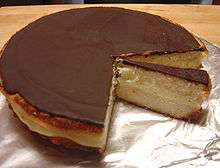
The official state dessert of Massachusetts, the Boston cream pie, is a chocolate-glazed, layered yellow sponge cake filled with pastry cream. It may be based on the Washington Pie, originally two layers of yellow sponge cake with jam filling and a dusting of icing sugar.[6] The first known written recipe from the 1878 Granite Iron Ware Cook Book uses baking powder for the sponge. Maria Parloa published several recipes for cream pie, includes one for chocolate cream pie. Parloa's recipe is the closest to the modern Boston Cream Pie.[16]
Génoise cake
The Génoise cake evolved from pan de spagna. The addition of butter by French pastry cooks created a cake texture that more resembled pound cake than traditional sponge cake. Techniques were developed to make the cake lighter, including beating the eggs over heat, or beating the egg yolks and whites separately.[17]
Pão-de-Ló
This sponge variation from Portuguese cuisine is flavoured with lemon or orange peel. It is served plain, and day old cake may be incorporated into other desserts like puddings. The pão-de-Ló de Alfeizerão is lightly baked to a pudding like consistency and flavored with brandy. Anecdotal legends about the cakes origin associate it with a secret recipe passed down by nuns to the village of Alfeizerão. The manufacture for commercial markets began during the Portuguese Revolution of 1910. [18] The Pão-de-Ló evolved from the old French pain de lof, which in turn was a Dutch borrowing from loef.[19] All variants loef, lof, ló refer to a nautical sail or cloth’s side where the wind blows.[20] The French adopted the Italian Genovese version of the cake and called it génoise. In Italy the cake was known as pan di spagna. Also in France and Portugal the same equivalent terms were used around the 16th century, respectively pain d’Espagne and pão de Hespanha/pão de Castella. Introduced to Japan by Portuguese traders in the 16th century, the Japanese variations on the cake are known as castella, kasutera or simply pan.[6] [21]
Plava
Plava is a sponge cake that is found in Jewish cuisine and usually eaten during Pesach. The batter is leavened with eggs and frequently includes flavorings like lemon zest or almond essence.[22]
Swiss roll
A swiss roll is a thin sponge cake that is spread with a layer of filling and rolled.[23]
Tipsy cake
Isabella Beeton, also known as Mrs. Beeton, included a recipe for her version of Tipsy Cake in Mrs Beeton's Book of Household Management where the cake was baked in a decorative mold before it was soaked in sherry and brandy with custard poured over, or broken into smaller pieces and topped with whipped cream like trifle.[24]
Trifle
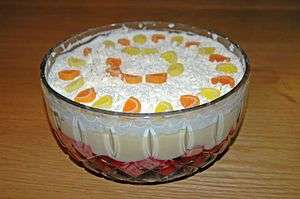
The earliest known form of trifle was a simple thickened cream flavored with sugar, rosewater and ginger but recipes for egg-thickened custard poured over sponge fingers, almond macaroons and sack-soaked ratafia biscuits are known from the mid-18th century. In 1747 Hannah Glasse adds syllabub and currant jelly over the custard. Similar recipes are known for the same time with the sponge soaked in sherry, wine or fruit juice. Eliza Acton's recipe for "Duke's Custard" was made from custard poured over brandied cherries rolled in sugar with sponge fingers (or macaroons) and pink whipped cream. Wyvern complained that trifle "should be made to time-honored standards, and not debased into a horror of stale cake, mean jam, canned fruits, packet jelly and packet custard."[24]
Victoria sponge
The Victoria sponge, also known as the Victoria sandwich cake, was named after Queen Victoria, who was known to enjoy the small cakes with her afternoon tea. The version Queen Victoria ate would have been filled with jam alone, but modern versions often include cream.[25] The top of the cake is not iced or decorated apart from a dusting of icing sugar. The recipe evolved from the classic pound cake made with equal proportions of flour, fat, sugar and eggs. The invention of baking powder in 1843 by English food manufacturer Alfred Bird allowed the cake to rise higher than was previously possible.[25][14] Cookery author Felicity Cloake writes that this invention "was celebrated with a patriotic cake"—the Victoria sponge.[25] According to Alysa Levene of Oxford Brookes University the term "sponge" is used "erroneously" for the Victoria Sandwich cake:
"The pound cake became popular in Britain in the eighteenth century as cake moved away from its heavy, fruity incarnations toward something lighter and more golden, eventually becoming the iconic Victoria sandwich cake (also known – erroneously – as a Victoria sponge)"[26]
A Victoria sponge is made using one of two methods.[13] The traditional method involves creaming caster sugar with fat (usually butter), mixing thoroughly with beaten egg, then folding flour and raising agent into the mixture. The modern method, using an electric mixer or food processor, involves simply whisking all the ingredients together until creamy.[27][9][28] Additionally, the modern method typically uses an extra raising agent, and some recipes call for an extra-soft butter or margarine.[13] This basic "cake" mixture has been made into a wide variety of treats and puddings, including cupcakes, chocolate cake, and Eve's pudding.[27][28][9]
Religious celebrations
At Passover
Since sponge cakes are not leavened with yeast, they are popular dessert choices for the Passover feast.[29] Typically, Passover sponges are made with matzo meal, shredded coconut,[30] matzo flour, potato flour, or nut flour (almond, hazelnut etc.) since raw wheat products may not be used.[31] No raising agent may be used due to the strict prohibition of even the appearance of a leavening effect. Therefore, the beating of egg whites in the mix to achieve the aeration is an essential characteristic of any Passover sponge recipe. Many families have at least one recipe they pass down through generations, and matzo meal-based cake mixes are available commercially. Several brands are easily found in kosher stores, especially before Passover. Typical flavorings include almonds, apples, dark chocolate, lemon, pecans, and poppy seeds. Apple or orange juice is the liquid ingredient. Milk is avoided, because it cannot be included in a dessert to be served after a meat based meal. The sponge, or a heavier variant in the form of an almond pudding, may be included as an element of the dessert in the Passover meal during the Seder service, when it is often combined in serving with a fruit compote.[32][33]
On Christmas
The Yule log is a Christmas dessert made from a sheet of sponge cake spread with filling and rolled up. It is topped with chocolate to give the appearance of bark. Decorative elements like mushrooms made of meringue, spun-sugar spiderwebs or crushed pistachios can be added to enhance the cake's finished appearance.[6]
Image gallery
- Pandan cake is a sponge cake of Southeast Asian origin. The cake-making technique was brought into Asia through European trade or colonisation.
- Tres leches cake is a sponge cake soaked in three kinds of milk: evaporated milk, condensed milk, and heavy cream.
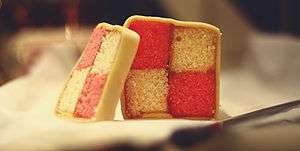 Homemade Battenberg cake covered in marzipan and, when cut in cross section, displays a distinctive two-by-two check pattern alternately coloured pink and yellow.
Homemade Battenberg cake covered in marzipan and, when cut in cross section, displays a distinctive two-by-two check pattern alternately coloured pink and yellow.
References
- Oxford English Dictionary
- "Sponge cake". BBC. Retrieved 2019-11-19.
- Castella, Krystina (2010). A World of Cake: 150 Recipes for Sweet Traditions From Cultures Around the World, pp. 6–7. ISBN 978-1-60342-576-6.
- Davidson, Alan (2002). The Penguin Companion to Food. Penguin Books. p. 147.
- Humble, Nicola. Cake: A Global History.
- Oxford Companion of Sugar and Sweets
- Byrn, Anne (2016-09-06). American Cake: From Colonial Gingerbread to Classic Layer, the Stories and Recipes Behind More Than 125 of Our Best-Loved Cakes. ISBN 9781623365431.
- Tea at the Blue Lantern Inn: A Social History of the Tea Room Craze in America. St. Martin's Press. 2002. p. 44.
- Mary Berry's Ultimate Cake Book 1995 printing.
- Braker, Flo (2003). The Simple Art of Perfect Baking. ISBN 9780811841092.
- The Bulawayo Cookery Book. 1909. p. 114.
- Gisslen, Wayne (2017). Professional Baking, 7th Edition. Wiley.
- Cloake, Felicity (16 May 2013). "How to make the perfect Victoria sponge cake". The Guardian. Retrieved 17 May 2013.
- "Alfred Bird: Egg-free custard inventor and chemist". Birmingham Mail. Retrieved 25 February 2018
- E.B. Bennion (1997). The Technology of Cake Making. Springer. p. 15.
- Patent, Greg. "Boston Cream Pie". Cite journal requires
|journal=(help) - Krondl, Michael (2011). Sweet Invention: A History of Dessert. p. 152.
- DGADR https://tradicional.dgadr.gov.pt/pt/cat/doces-e-produtos-de-pastelaria/192-pao-de-lo-de-alfeizerao. Missing or empty
|title=(help) - S.A, Priberam Informática. "Consulte o significado / definição de ló no Dicionário Priberam da Língua Portuguesa, o dicionário online de português contemporâneo". dicionario.priberam.org.
- "ETIMOLOGIAS" (PDF). www.academiagalega.org. Retrieved 2020-07-13.
- "Kasutera: The cake introduced in Japan by the Portuguese in the 16th century - Heritage". May 16, 2012.
- Phillips, Denise. The Gourmet Jewish Cookbook. p. 239.
- Gisslen, Wayne (2004). Professional Baking. Wiley. p. 671.
- Norwak, Mary (2008-04-11). English Puddings: Sweet & Savoury. ISBN 9781910690574.
- "The great Victoria sandwich". The Telegraph. Retrieved 25 February 2018
- Levene, Alysa (2016-03-15). Cake: A Slice of History. ISBN 9781681771083.
- Be-Ro flour Home recipes 40th edition
- Delia Smith's Book of Cakes Sixth Impression 1981.
- Fabricant, Florence (March 28, 1993). "FOOD: Healthful Tips for Passover Favorites". New York Times. Retrieved October 20, 2007.
- "Raffaello Cake Recipe – Coconut & White Chocolate". VideoCulinary.com. Retrieved 2016-01-04.
- Fabricant, Florence (April 8, 1990). "FOOD: Meeting the Challenge of a Dessert for the Passover Meal". New York Times. Retrieved October 20, 2007.
- "Shalom Boston – Traditional Passover Seder Menu".
- Nathan, Joan (1998). Jewish Cooking in America. ISBN 9780375402760.
External links
| Wikimedia Commons has media related to Sponge cakes. |
